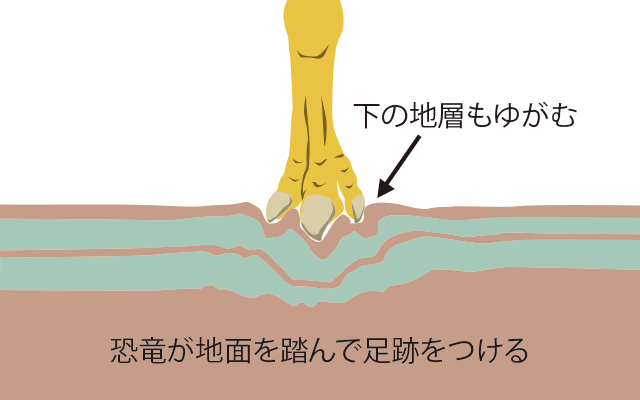
御船層群に残された骨と足跡
御船層群の骨化石層は多様な化石を含み当時の動物群集を浮きぼりにする
御船層群では、魚類から哺乳類に至る多様な種類の化石で構成される骨化石層と、恐竜の足跡化石が含まれる特徴的な化石層が見られる。
骨化石は河道に堆積した砂岩層に保存されており、その中には小型の脊椎動物化石が集中して含まれる。化石の特徴としては、ひどく磨耗した痕は見られないものの、脆性的に破壊された断面を持つことが多い。そのため、もともと流路の近くに存在した化石層が洗いだされ、河道の中に再び堆積した二次堆積物である可能性が考えられる。
一方、恐竜の足跡化石は、泥と砂の薄層が交互に重なる地層に残されている。このような地層は一般的に被子植物の大型葉体化石を含んでおり、河川の周囲に発達した自然堤防から氾濫原において形成されたものだと考えられる。
Dinosaur Bones and Footprints Left in the Mifune Group.
Mifune group formation’s bone bed layer contains a lot of fossils, highlighting the fauna of this time.
Mifune group formation is composed of layers containing various types of fossils such as fishes and mammals but also some characteristic fossil layers containing dinosaur footprints.
All kind of material and in particular small vertebrate fossils are conserved in the sandstone layers that were deposited in a river channel. Those fossils, even not too badly worn, have often characteristically their cross-section broken in a brittle manner, indicating that the fossil layer, that was created in the vicinity of the original river flow path, has been washed out and overlapped once again by a second deposit in the river channel.
On the other hand, dinosaur footprints have been left in a formation composed of alternating thin layer of mud and sand.
Such formations, generally include Angiosperm’s large leaf fossils, are thought to be a natural levee built around the river during floodplain.